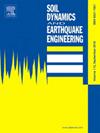Analytical solutions for determining the most unfavorable moment of shaking occurrence in underwater shaking table tests
IF 4.2
2区 工程技术
Q1 ENGINEERING, GEOLOGICAL
引用次数: 0
Abstract
Responses of structures under coupled earthquake and wave-current actions are greatly influenced by the difference between occurrence times of earthquake and wave-current action. Aiming to obtain the most dangerous scenario of the structure (i.e. the maximum structural response) from underwater shaking table (UST) tests, the most unfavorable moment of shaking occurrence in UST tests was analytically investigated in this study through three steps. Firstly, analytical solutions for natural frequencies of structures submerged in water were proposed. Underpinned by the calculated frequencies, the time corresponding to the maximum responses of structures under earthquakes in still water (ES) was solved utilizing the mode superposition method. Secondly, simplified Morison equations were proposed to solve the time corresponding to maximum wave-current forces. Then, the time corresponding to the maximum responses of structures under wave-current (WC) action was solved by considering the time lag between excitations and responses. Thirdly, the calculation method for the most unfavorable moment of shaking occurrence in UST tests was proposed through comprehensive analyses of the theoretical results of structures under ES and WC conditions. Finally, underpinned by a numerical model, which can accurately reproduce the structural responses under coupled earthquake and wave-current (EWC) actions, all the new proposals were comprehensively validated, considering different parameters of structures and excitations. The results showed that the proposed analytical method has sufficient accuracy in determining the most unfavorable moment of shaking occurrence in UST tests. The analytical methods proposed in the current paper provided a firm basis for the design and implementation of UST tests.
求助全文
约1分钟内获得全文
求助全文
来源期刊

Soil Dynamics and Earthquake Engineering
工程技术-地球科学综合
CiteScore
7.50
自引率
15.00%
发文量
446
审稿时长
8 months
期刊介绍:
The journal aims to encourage and enhance the role of mechanics and other disciplines as they relate to earthquake engineering by providing opportunities for the publication of the work of applied mathematicians, engineers and other applied scientists involved in solving problems closely related to the field of earthquake engineering and geotechnical earthquake engineering.
Emphasis is placed on new concepts and techniques, but case histories will also be published if they enhance the presentation and understanding of new technical concepts.
 求助内容:
求助内容: 应助结果提醒方式:
应助结果提醒方式:


